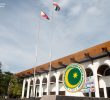The more the economy is stagnant, the less its ability to create jobs, the more dependent government becomes on overseas labor deployment.
By the Policy Study, Publication and Advocacy (PSPA) Program
Center for People Empowerment in Governance (Cenpeg)
If the state policy making and legislative agenda do not change course, the whole nation will wake up one day to find that remittances accumulated through off-shore migration or labor exportation have become government’s No. 1 pillar of economic sustainability. Right now, foreign trade and investment – steered by neo-liberal globalization – and reliance on overseas development assistance are the first two pillars, followed by the export of Filipino labor. The state policy of globalization as specified by privatization, liberalization, deregulation, and labor-only contracting binds the three major pillars together.
Labor migration has become the safety valve to the country’s unemployment crisis and a major source of foreign exchange: It has surged way past the domestic job market as the remaining option for many Filipinos. In 2000 alone, more than 800,000 Filipinos were deployed abroad while only less than 200,000 were effectively added to the domestic labor market.(1) As unemployment has worsened under the Arroyo administration compared to the past 50 years some 3,000 Filipinos leave the country every day for overseas jobs – or a total of more than 1 million every year. With remittances growing by the year – 14.4 billion US dollars in 2007 constituting 10 percent of the country’s GDP – the government target is to increase labor migration to 2 million by 2010.(2) And the government is determined to meet the target: From January to April this year there were 516,466 migrant workers deployed thus raising the daily departure to 4,314 from last year’s 3,000.
In fact remittances sent by overseas Filipinos have outstripped both foreign direct investment (FDI) and overseas development assistance (ODA) which have declined in the past several years. FDI was 2.93 billion US dollars in 2007 but minus payments to loans the actual investment inflows fell by 69.3 percent to only 341 million US dollars. Last year’s 14.4 billion US dollars remittances is equal to 25 percent of the total ODA received by the Philippines – that is, in 20 years or from 1986-2006 (39.9 billion US dollars).
In general, last year global foreign remittances already totaled thrice the amount of aid given by donor countries to developing nations: 300 billion US dollars against 104 billion US dollars . No wonder labor migration is now being trumpeted by the United Nations and other multilateral organizations as a centerpiece program for developing economies.
For a government whose economic policy is subordinated to bitter policy prescriptions of the IMF and WB and adherence to the World Trade Organization (WTO), the Arroyo regime’s agenda to make labor migration as a major source of government income received a boost from no less than UN secretary general Ban Ki-moon. Speaking before the Global Forum on Migration and Development (GFMD) on Oct. 29 in Manila, Ban Ki-moon, who is also South Korea’s former foreign minister, hailed migration as “a tool to help lift us out the (current global) economic crisis �(where) countries can draw the greatest possible development benefits.”
A model for migration
Organizers of GFMD chose Manila as the forum venue on account of the Philippines’ being a role model for labor migration among developing countries and chiefly because of the remittances accruing from foreign employment. Of some 8.2 million Filipinos(3) living and working in more than 193 countries/territories around the world, 43 percent are permanent immigrants while the rest or 4.7 million are temporary or contract workers. The Philippines is one of the leading sources of migrant labor in the world market. But it tops in the deployment of caregivers and domestics, 90 percent of them women, as well as in nurses, seafarers (30 percent of the world supply), and other medical workers and professionals.
Hypocritically since the Marcos years, the government denies the existence of a labor export policy. What it cannot hide however is the existence of a government infrastructure developed since the Marcos years that gives prime attention to the export of Filipino workers and professionals. This infrastructure promotes and processes out-migration, exacts – extorts, if you will – various exorbitant fees from outgoing OFWs, accredits recruitment agencies, provides skills training and immigration lectures, and supposedly earmarks benefits for the migrant workers and their families. This bureaucracy, which is headed by the President, includes the labor department’s Philippine Overseas Employment Agency (POEA), Overseas Workers Welfare Administration (OWWA), the National Labor Relations Commission (NLRC), Technical Education and Skills Authority (TESDA), and the Department of Foreign Affairs (DFA) with its office of migrant affairs and various Philippine Labor Offices (POLOS) based in many countries.
OFWS & Migration









